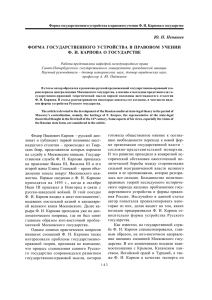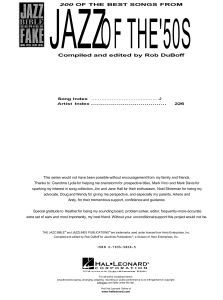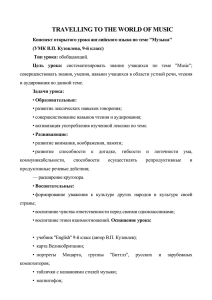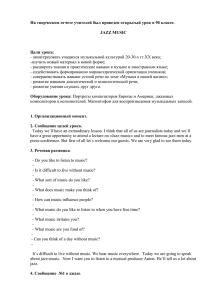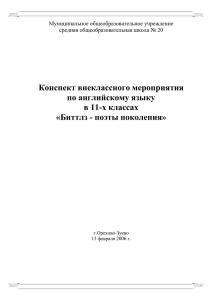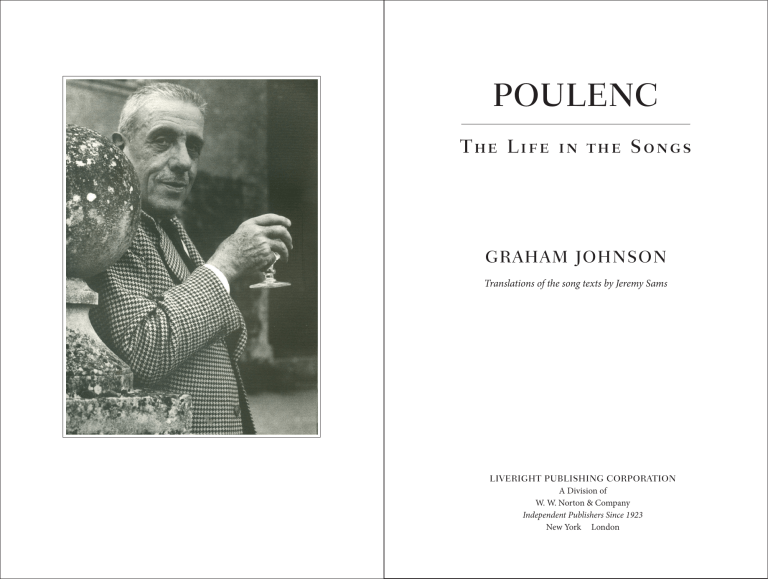
POULENC Th e Li f e i n th e Songs GRAHAM JOHNSON Translations of the song texts by Jeremy Sams LIVERIGHT PUBLISHING CORPORATION A Division of W. W. Norton & Company Independent Publishers Since 1923 New York London Contents Preface 000 Acknowledgments 000 ° I ° Outline of a Musical Life: 1855–1919 000 Songs for a New Century 000 Rhapsodie nègre (Kangourou) FP3 000 Toréador (Cocteau) FP11 000 Le Bestiaire, or cortège d’Orphée (Apollinaire) FP15a 000 Two unpublished songs from Le Bestiaire FP15b 000 Biographical Interlude: Guillaume Apollinaire Cocardes (Cocteau) FP16 000 ° II ° Outline of a Musical Life: 1920–1929 000 Songs of the Twenties 000 Poèmes de Ronsard FP38 000 Chansons gaillardes FP42 000 Vocalise FP44 000 Airs chantés pour soprano d’après poèmes de Jean Moréas FP46 000 ix x ° Contents ° III ° Outline of a Musical Life: 1930–1939 000 Songs of the Thirties 000 Épitaphe (Malherbe) FP55 000 Trois Poèmes de Louise Lalanne (Laurencin/Apollinaire) FP57 000 Quatre Poèmes de Guillaume Apollinaire FP58 000 Cinq Poèmes de Max Jacob FP59 000 Pierrot (Banville) FP66 000 Huit Chansons polonaises (Osiem piesńi polskich) FP69 000 Quatre Chansons pour enfants (Jaboune) FP75 000 Cinq Poèmes de Paul Éluard FP77 000 Biographical Interlude: Paul Éluard 000 À sa guitare (Ronsard) FP79 000 Tel jour telle nuit (Éluard) FP86 000 Trois Poèmes de Louise de Vilmorin FP91 000 Le Portrait (Colette) FP92 000 Poulenc’s People: Friends, Colleagues, Dedicatees, Publishers 000 The Masks and Myths of Francis Poulenc and His Eventual Triumph 000 Notes 000 Bibliography 000 Index of Names 000 Index of Songs 000 Preface Of Poulenc’s genius, and of his importance in French music, there can now be little doubt. It has been more than half a century since his death, and the passing of time has done little to diminish his reputation; indeed, the opposite is true. On the day of his death, 30 January 1963, it could not be stated with any certainty that his compositions would endure. Cultural values were changing with dizzying speed in a new age of science, with the British prime minister promising that the future lay in “the white heat of technology.” The Cuban missile crisis had recently threatened universal destruction, the Soviet Union had launched a man into space, and it seemed as if the arts were destined, or doomed, to rocket into the same trajectory. The serialists of the “Domaine musicale” and Darmstadt, Pierre Boulez and Karlheinz Stockhausen and their disciples, were convinced that the future was theirs for the taking, and that the public would soon be weaned from a diet of music by insignificant tonal dabblers. At the times of their passing, both Poulenc and Benjamin Britten (they died thirteen years apart, at more or less the same age) had faced up to the prospect of being more or less forgotten. And yet both composers are now acknowledged as among the twentieth century’s most significant masters of vocal music—solo, choral, and operatic—quite apart from their achievements in instrumental spheres. Poulenc was always content to measure his success and status in national rather than international terms: Parisian opinion counted most, and French song, not German, English, or American, was what really mattered to him. Just as Hugo Wolf in Vienna (caring not at all what Gabriel Fauré or Claude Debussy might be doing) opined that no one had written songs like his since Franz Schubert and Robert Schumann, Poulenc (far too diplomatic to boast openly but more direct with friends) was no shrinking violet when it came to his own private estimation of where his mélodies stood in the world: “In the field of song I fear no one, and being the best [“la primauté”] is always very pleasant.”1 Posterity has come to agree with him, more or less: his songs feature on singers’ programs throughout the world, while those of most ° xi xii ° Preface of his contemporaries (the other members of Les Six, for example) appear only occasionally and modestly. But while it is true that Poulenc’s songs are everywhere loved and enjoyed, one cannot always assume that they are taken seriously. It might be fair to say that some of his music is loved for the wrong reasons, even if treated affectionately and indulgently. To amuse and delight was not his only aim. What it cost Poulenc to create his life’s work has always been underestimated, as has the almost Proustian manner in which he drew on his visual memories and pricked up his avid, pickpocketing ears to create a synthesis of his own past and present—a brand of nostalgia so much his own that “nostalgia” seems an inadequate word, not creative and forward-looking enough, just as “nostalgia” is thoroughly unequal to defining Proust’s searches for lost time. Perhaps we are now at a sufficient distance from Poulenc’s era to understand how truly extraordinary his music is, a one-off. In fact, we should be very grateful that he had a composing career at all—it needed propitious circumstances and great personal determination, bravery even, for such a fragile and unusual talent to thrive. It was similarly touch and go whether Schumann, initially known as a pianist and critic, would become a composer. I regard this great German Romantic as one of Poulenc’s spiritual antecedents, not least in terms of a mysterious affinity with poets: Schumann’s with Heinrich Heine and Joseph von Eichendorff and Poulenc’s with Apollinaire and Paul Éluard. Schumann’s route to the making of music was spectacularly different from that of his musical forebears: he was inspired by verbal and literary allusions, his piano music of the late 1830s freshly woven from the prose of Jean Paul and E. T. A. Hoffmann. We also hear his homage to composers as widely different as Frédéric Chopin and J. S. Bach—Chopin receiving from Schumann one of the most generous critical compliments ever paid by one contemporary genius to another.2 Acknowledgments I got to know the songs of Robert Schumann and Francis Poulenc more or less at the same time in the early 1970s. The late Eric Sams (who did not care for Poulenc) was my beloved guide and mentor in the world of lieder, and his son Jeremy, six years my junior, was already the polished Poulenc expert; to my utter astonishment, he already knew many of the songs, and their words, by heart. More than forty years later, Jeremy’s translations of the poetry for this book, and his name on the cover together with mine, bring the Poulencian part of my own life full circle in a way I could scarcely have imagined. This book could not have been written without the help of the Leverhulme Trust and The Songmakers’ Almanac. At the Guildhall School of Music and Drama I have had indispensable support from Dr. Helena Gaunt, Dr. Cormac Newark, and Pamela Lidiard. For my entire career I have performed the songs of Poulenc with Dame Felicity Lott, and I am grateful to her for reading parts of the book that could not have been written without those years of working on this repertoire together. I am further indebted to Sidney Buckland, Mimi Daitz, Dr. David Foreman, Katy Hamilton, Uri Liebrecht, the late Winifred Radford, Tony Scotland, the late Rosine and Jean Seringe, Benoit Seringe, Les Amis de Francis Poulenc, and Brandon Velarde. My editor at Liveright has been the patient and marvelously efficient Susan Gaustad. xiii ° I° Outline of a Musical Life: 1855–1919 1855 Birth of Francis Poulenc’s father, Émile Poulenc (d. 1915). “My father came originally from Aveyron. He was, together with my two uncles, at the head of a very old chemical products firm which eventually became Rhône-Poulenc.” 1862 Birth of FP’s uncle and godfather Marcel Royer, nicknamed “Papoum” (d. 1945). 1865 Birth of FP’s mother, Jenny Royer (d. 1917). “My mother, of purely Parisian descent (since the beginning of the nineteenth century her family had only intermarried with Parisians), came from a line of cabinet-makers, bronze workers and tapestry weaver.” 1885 Marriage of FP’s parents at the church of Saint-Denys-du-Saint-Sacrement, in the rue de Turenne (18 March). 1887 Birth of FP’s sister Jeanne Élise Marguerite, in Nogent (d. 1974). 1888 Birth of FP’s brother Louis Étienne (d. 1891). Another child was stillborn in May 1892. 1897 Birth of Raymonde Linossier in Lyon (25 March). She would be a close friend of Poulenc from his childhood. 3 4 ° Poulenc: The Life in the Songs He plays the whole score through “from magic moment to magic moment,” thoroughly absorbed. FP’s first piano piece, En Barque, dates from this period. 1917 (aged 18) Through Ricardo Viñes, FP meets Erik Satie, a composer he considers an alternative guru to Debussy and Stravinsky. FP plays to Maurice Ravel, who is very critical and bad-tempered (March). Rapsodie nègre FP3 (Kangourou), composed in Paris (spring). The United States enters the Great War in Europe (6 April). FP hears the first performance of Debussy’s Violin Sonata, played by Gaston Poulet accompanied by the composer (5 May). More composers come into FP’s circle. He meets Arthur Honegger (1892– 1955) at the home of mezzo-soprano Jane Bathori, on the boulevard Pereire; there, André Caplet (1878–1925) conducts a choral ensemble, in which composer Charles Koechlin and Ricardo Viñes sing the bass line. (FP, who also sang, remembered being chided by Honegger for solfège mistakes.) He also meets two future members of Les Six, Louis Durey (1888–1979) and Germaine Tailleferre (1892–1983). FP attends the first performance at the Théâtre du Châtelet of Parade, a “ballet réaliste” with music by Erik Satie and décor by Picasso (18 May). Raymond Radiguet (1903–1923), a precocious writer, takes FP to meet poet Max Jacob (see p. 000) in Jacob’s lodgings in Montmartre. FP attends the first performance of Apollinaire’s surrealistic play Les Mamelles de Tirésias (24 June), at the Théâtre René Maubel in Montmartre. He had possibly met Apollinaire earlier at the home of Valentine Hugo (1887– 1968). It is more certain that he hears the poet give a reading at Monnier’s bookshop. FP’s father, Émile Poulenc, dies on 15 July. As with his mother, there is no surviving documentary reaction from the son to this loss. Poulenc, technically an orphan who has not yet attained his majority, is placed under the care of a “curateur” at 3, rue de Saint-Simon. He then moves in with with his sister and brother-in-law, André Manceaux (1883–1967), at 76, rue de Monceau. When the Manceaux move to 83, rue de Monceau in 1919, FP occupies a bachelor flat (“garçonnière”) above what had been the stables. Through his friend Emanuel Faÿ, FP meets the patron of music and art Comte Étienne de Beaumont (1883–1956). FP, in search of a composition teacher, has an explosive encounter with the conductor Paul Vidal (1863–1931), who all but throws the young composer out on reading through the score of Rapsodie nègre and seeing its dedication to Erik Satie (26 September). Outline of a Musical Life: 1855-1919 ° 5 Satie, delighted with the Vidal fiasco, takes Poulenc under his wing as a member of “Les Nouveaux Jeunes,” a group of composers that includes Auric, Louis Durey, Honegger, and Satie as patron. “The orchestration of Parade and the transparency of Socrate were the two influences that enabled us to turn our backs on the spells of Debussy and Ravel exactly when it was imperative to do so.” First public performance of Rapsodie nègre FP3, at the Théâtre du Vieux-Colombier, Paris (11 December)—at a matinee billed as Musique d’Avant-Garde that includes works by Satie, Stravinsky, Auric, and Durey among others. 1918 (aged 19) FP’s military service begins on 18 January and ends almost exactly three years later. He is initially sent to Vincennes, 6.5 kilometers from Paris, and given a job as a driver. “I didn’t know the countryside until I was 18, when I joined the army.” Le Coq et l’arlequin, a tract on music and aesthetics by Jean Cocteau, is published in March. Paris is bombarded by German artillery (March 23–August 7). FP encounters poet Paul Éluard at Adrienne Monnier’s bookshop. He meets composer Manuel de Falla at the home of Ricardo Viñes. FP collaborates for the first time with Jean Cocteau (see p. 00). In late August, FP is briefly assigned to the 63rd Régiment d’Artillerie in the Val d’Oise, not far from Paris. He is imprisoned for a week for having slept in Paris without permission and reassigned to the 66th regiment at Saint-Martin-sur-le-Pré, 165 kilometers from his home city. In December another reassignment places him closer to Paris. Despite being fortunate enough never to have been subject to the horrors of the Front, Poulenc still complains: “I am truly beginning to feel the stupid and strict discipline of the army.” Caption here 6 ° Poulenc: The Life in the Songs Toréador FP11 (Cocteau), composed in Paris (autumn 1918). Violinist Hélène Jourdan-Morhange (1892–1961) takes FP to the home of Jean de Polignac in Neuilly, where he finally meets Marguerite di Pietro, who will eventually marry Jean. As Marie-Blanche, Comtesse de Polignac, this gifted pianist and singer will become one of FP’s closest friends and supporters, and the dedicatee of fourteen songs. Birth of Rosine Manceaux (later Mme Jean Seringe, d. 2017), FP’s younger niece (3 October). Following the sudden death of her sister Brigitte in 1963, Rosine will inherit Poulenc’s house in Noizay, manage his “droit moral,” and head Les Amis de Francis Poulenc for fifty years after her uncle’s death. Erik Satie resigns in high dudgeon from “Les Nouveaux Jeunes” (1 November). Apollinaire, weakened by long-term complications from his war wound, succumbs to the Spanish flu and dies, on 9 November. The first armistice between France and Germany is signed at Compiègne, ending the Great War. France regains control of Alsace-Lorraine (11 November). FP continues with his military duties: “Truly the countryside is something frightful for young persons, especially in circumstances such as those in which I find myself.” 1919 (aged 20) In mid-January FP is assigned to the Défense Contre Avions (DCA) at Pontsur-Seine, twenty kilometers from Paris. Adrienne Monnier sends Poulenc a re-issue of Apollinaire’s Le Bestiaire, featuring woodcuts by Raoul Dufy (January). Erik Satie accompanies Suzanne Balguerie (1888–1973) in a performance of his Socrate, Part I, at Monnier’s bookshop (March 21). FP meets Sergei Diaghilev at the home of pianist and arts patron Misia Sert and plays him Rapsodie nègre. The connection between impresario and composer is immediately warm (April). Le Bestiaire FP15a (Apollinaire), composed in Pont-sur-Seine (April– May). For the first private performance of Le Bestiaire, FP accompanies soprano Suzanne Rivière, who is soon to work under her married name, Suzanne Peignot (1895–1993). Cocardes FP16 (Cocteau), composed in Pont-sur-Seine (April–June). First public performance of Le Bestiaire FP15a, at the gallery L’Effort Moderne, Paris (8 June). The concert is a “Matinée poétique” in memory of Apollinaire. Jeanne Borel is accompanied by FP. The Treaty of Versailles (France insisting on unrealistically punitive terms Outline of a Musical Life: 1855-1919 ° 7 for Germany, with disastrous long-term consequences) is signed in the Hall of Mirrors at Versailles, just outside Paris (28 June). In July FP obtains a desk job at the war office in Paris, remaining there until he is released from military service in January 1921. On the recommendation of Diaghilev and Stravinsky, the firm of J & W Chester in London begins to publish FP’s instrumental music. With support from director Otto Marius Kling and poet Georges Jean-Aubry, editor of the influential house magazine The Chesterian, FP begins to build a reputation in Britain. Through Jean-Aubry, FP wins the friendship and encouragement of Albert Roussel—a composer whose music is not to his taste, but whom he likes and respects. At the home of René Chalupt, an amateur poet set by Satie and Roussel, FP once again encounters Milhaud (recently returned from Brazil) and performs Le Bestiaire for him. They become fast friends. FP dares to invite Diaghilev to dinner at 83, rue de Monceau (12 September). Songs for a New Century ° Kaka nounou nounouranga, lolo, luluma, tamasou. Pata tabo, ananalou, Mandès, Golas, Gbêles i Krous. [names of Liberian tribes] Bananalou ityo Kouskous, Poti lama, Honoloulou! Songs for a New Century Melopée pour automne (for piano), preceded by a quotation from Verlaine’s “En sourdine”: “Calmes dans le demi-jour” (unpublished), 14 March 1913 Viens (Victor Hugo, for voice and piano), probably a wedding present for Jeanne and André Manceaux (unpublished), 2 June 1913 FP1 Processional pour la crémation d’un mandarin (piano, destroyed by the composer), 1914 FP2 Préludes (piano, destroyed), 1916 ° ° ° FP3 Rapsodie nègre (third movement) Composed in Paris, spring 1917 (revised 1933) [Erik Satie (dedicatee); Chester (publisher)] Literary source: Les Poésies de Makoko Kangourou, ed. Marcel Prouille (another pseudonym of the author, Marcel Ormoy, 1891–1934) and Charles Moulié (Paris: Dorbon Ainé, 1910). The bracketed information below is printed as pseudo-scholastic footnotes in the original publication, as is the supposed date, 11 January 1892. A minor; ½ [sic]; Lent et monotone [crotchet] = 69 Honoloulou [written by Makoko Kangourou in his mother tongue] Honoloulou, poti lama! [Honoloulou is the name of Kangourou’s girlfriend] Honoloulou, Honoloulou, Kati moko, mosi bolou Ratakou sira, polama! Watakousi, motimasou, Etchepango ectehpanga, 8 9 Poulenc claimed to have discovered Kangourou’s book of poems in a stall along the banks of the Seine. The five-movement work (Prélude, Ronde, Honoloulou— Intermède vocal, Pastorale, Final), dedicated to Erik Satie, is scored for piano, two violins, viola, cello, flute, and clarinet; the third movement is for voice and piano alone, which qualifies this strange piece for inclusion here. It was, as Poulenc explained, “a reflection of the taste for African art that had flourished since 1912 under the impetus of Apollinaire.” Just before its first performance, “the baritone [a M. Feiner] threw in the towel saying it was all too stupid and he didn’t want to be taken for a fool. . . . I had to sing this interlude myself, partially obscured by a huge music stand. As I had aready been mobilized one can imagine the unexpected effect of this soldier bawling in pseudo-Malagasy.” The music for the sung movement is in a repetitive style that would today be labeled minimalist: a cell of descending eighth notes (B, A, G-sharp, F-sharp) is heard nineteen times in all (the words to be sung sans nuances), the iterations slightly different in rhythm and duration but never straying from the same four notes, an inadvertent prophecy of the exotic linguistics and musical stasis in some of Messiaen’s music from decades later. A four-bar postlude, two bars of which consist of pianistic flourishes in different octaves, is finished off by two chords and a final bass note (A) that ground the piece in a modal variant of A minor. We hear the future Poulenc in the music’s inventive audacity rather than in any command of melody, harmony, or form. ° ° ° Scherzo for Two Pianos (Zèbre) (lost or destroyed), 1917 Trois Pastorales (piano), autumn 1917 Poèmes sénégalais (voice and string quartet); no trace of the songs has been found, and the origin of the texts is unknown. FP7 Sonata for Two Clarinets, spring 1918 FP8 Sonata for Piano Four Hands, June 1918 FP9 Prélude percussion (to precede the ballet Le Jongleur), October 1918 FP10 Le Jongleur, orchestrated by January 1919 FP4 FP5 FP6 ° ° ° 10 ° Poulenc: The Life in the Songs Songs for a New Century ° FP11 Toréador (Chanson hispano-italienne) Composed in Paris, autumn 1918 (revised 1932) [Pierre Bertin; Deiss] Literary source: Jean Cocteau (1889–1963) <D major; 3/8; Allant [dotted quarter] = 92 1 Pépita reine de Venise Quand tu vas sous ton mirador Tous les gondoliers se dissent Prends garde toréador! 2 Sur ton coeur personne ne règne Dans le grand palais ou tu dors Et près de toi la vieille duègne Guette le toréador. 3 Toréador brave des braves Lorsque sur la place Saint-Marc Le taureau en fureur qui bave Tombe tué par ton poignard 4 Ce n’est pas l’orgueil qui caresse Ton coeur sous la baouta d’or Car pour une jeune déesse Tu brûles toréador. Refrain Belle Espagno o le Dans ta gondo o le Tu caraco o les Carmencita! Sous ta manti i lle Oeil qui pét i lle Bouche qui bri i lle C’est Pépita a a 5 C’est demain (jour de Saint Escure) Qu’aura lieu le combat à mort 1 Pepita, queen of Venice When you go out onto your balcony All the gondoliers are thinking “Beware . . . Toreador!” 2 Nobody is master of your heart In the grand palazzo where you sleep And nearby the old duenna Keeps an eye out for the Toreador. 3 Toreador, bravest of the brave When on the Piazza San Marco The angry slavering bull Falls slain by your blade 4 It’s not pride which fires Your heart, beneath your gilded cape No, it is for a young goddess That you are burning, Toreador. Refrain Lovely Spanish lady In your gondola Preening yourself Carmencita! Beneath your mantilla Sparkling eye Shimmering mouth That’s Pepita. <<stanza break>> 5 Tomorrow (St. Escurio’s day) Is the day of the fight to the death 11 Le canal est plein de voitures Fêtant le toreador. 6 De Venise plus d’une belle Palpite pour savoir ton sort Mais tu méprises leurs dentelles Tu souffres toréador. 7 Car ne voyant pas apparaître (caché derrière un oranger) Pépita seule à sa fenêtre Tu médites de te venger, 8 Sous ton caftan passe ta dague La jalousie au coeur te mord Et seul avec le bruit des vagues Tu pleures toréador The Grand Canal is full of carriages All celebrating the Toreador! 6 More than one Venetian beauty Trembles to know your fate But you scorn their lace finery You’re suffering, Toreador. 7 For since you cannot see (concealed behind an orange tree) Pepita, alone at her window, You are plotting revenge. 8 Under your caftan you’ve slipped a dagger Jealousy gnaws at your heart And all alone, to the lap of the waves You’re weeping, Toreador. Refrain Refrain 9 Que de cavaliers! Que de monde! Remplit l’arène jusqu’au bord! On vient de cent lieues à la ronde T’acclamer toréador! 10 C’est fait il entre dans l’arène Avec plus de flegme qu’un lord. Mais il peut avancer a peine Le pauvre toréador. 11 Il ne reste à son rêve morne Que de mourir sous tous les yeux En sentant pénétrer des cornes Dans son triste front soucieux 12 Car Pépita se montre assise Offrant son regard et son corps Au plus vieux doge de Venise Et rit du Toréador. 9 So many horsemen! So many people! Filling the bullring to bursting People come from a hundred miles around To cheer you, Toreador! 10 We’re off! He enters the ring With more cool than a lord But he can hardly walk The poor Toreador. 11 All that’s left of his gloomy dream Is to die in front of everyone And to feel the bull’s horns Gore his sad furrowed brow 12 For there is Pepita, sitting And offering her gaze and her body To the oldest Doge in Venice And laughing at the Toreador. Refrain Refrain 12 ° Poulenc: The Life in the Songs Poulenc’s main preoccupation between fall 1918 and spring 1919 (when he was on nonactive military duty) was writing a ballet, music-hall style, entitled Le Jongleur (he sometimes referred to it as Jongleurs). This was to be performed for a Jean Cocteau-inspired “Séance−Music Hall” at the Théâtre du Vieux-Colombier, an event for which Toréador was also destined. Plans for Cocteau’s Séance−Music Hall collapsed, and Le Jongleur, clearly a disappointment to Poulenc, was quickly withdrawn; the score has long since disappeared. But Toréador survived. It was not quite his first Cocteau piece—that honor belongs to Zèbre FP4, a lost scherzo for two pianos from the summer of 1917, inspired by Cocteau’s poem of the same name. Poulenc received the poem for Toréador from Cocteau himself, together with the instruction to show it to no one else (the poet clearly felt he could better control his musical collaborators if they were kept in the dark about what the others were doing). Cocteau wanted his lyric composed in the style of “Bobino,” the famous music hall in Montparnasse belonging to the Pathé Brothers, and featuring such variety artists as Mistinguett, a female singer-entertainer much admired by the young Poulenc. Shamelessly micromanaging, Cocteau urged Poulenc not to make the song sound too much like Chabrier, but rather “bien mais moche” (good but trashy), finishing with “rapid quarter notes” (he was no schooled musician). He also insisted that the final syllables of words like “Venise” (“Veni-se”) should be emphasized. Early in 1919 Poulenc assured the poet that versions of Toréador for voice and piano and for voice and instruments were with the copyist—the only time we hear of an instrumental accompaniment, the score for which (if it existed) has since disappeared. At the later urging of painter Jacques-Émile Blanche, the chanson (clearly no mélodie) was eventually published in 1932 by Deiss. Cocteau’s cover design shows the toreador’s costume decorated with the poet’s “rapid quarter notes” (rapidly drawn perhaps), as are the head and hooves of the bull. The song is a strictly strophic creation and, as Cocteau demanded, conceived in the manner of popular hits of the time. More often than not the vocal line is doubled by the piano; the refrain is sung slower the third time round, and the marking of Très rubato at bar 55 is a very unsual one for this composer. The story concerns Pépita, so-called queen of Venice, for whom a toreador conceives an unrequited passion. In a zany montage anticipating Monty Python by four decades, the bullring is transported to Venice’s Piazza San Marco, gondoliers become Spanish galleons, and the oldest doge in the city enjoys Pépita’s favors—whimsical nonsense that bows to the surrealists, but was hated by them for not taking surrealism seriously enough. Much later, during the broadcast of one of his fifteen conversations with Claude Rostand (1953–54), Poulenc described his madcap creation as a “Hispano-Italian ditty . . . which lampoons the geography of the café-concert songs of the time, in which a Japanese girl would go to the bad in Peking, and Sappho would fire questions at the Sphinx.” Songs for a New Century ° 13 There is no record of a first public performance, but it was sung often by the composer (in his nasal singing voice) in the company of other members of Les Six or at gatherings of friends. “Bernac maintains that I sing this song, forgive me, like nobody else,” he later wrote. “It is enough to say that the voice does not matter for this interpretation of this musical pleasantry, and that the ‘oins oins’ coming from my nose, which is not Grecian, are sufficient to amuse the people for whom it is destined.” Toréador became a kind of theme song for the young composer. He performed it during the same 1950s broadcast with Rostand, accompanying himself—his sole radio appearance as a singer. ° ° ° FP12 Sonata for Violin and Piano (first version, destroyed), October 1918 FP13 Sonata for Piano, Violin, and Violoncello (lost or destroyed), October 1918 FP14 Trois Mouvements perpétuels (piano), December 1918 ° ° ° FP15a Le Bestiaire, ou cortège d’Orphé [The Bestiary, or Procession of Orpheus] Composed in Pont-sur-Seine, April–May 1919 (with the exception of vi, which Poulenc later claimed to have composed in February) [Louis Durey; Éditions de la Sirène] Literary source: Guillaume Apollinaire (1880–1918), Le Bestiaire, ou cortège d’Orphée, woodcut illustrations by Raoul Dufy (Paris: Deplanche, Éditeur d’Art, 1911). The pages of this edition are unnumbered; numbers refer to the poems’ position in the anthology: (i) 10, (ii) 4, (iii) 17, (iv) 19, (v) 22, (vi) 23.\ (i) (ii) (iii) (iv) (v) (vi) Le Dromadaire La Chèvre du Thibet La Sauterelle Le Dauphin L’Écrevisse La Carpe Apollinaire was an enthusiastic, if not wealthy, bibliophile. Subjects of his eclectic reading included magic, theosophy, religion, and medieval history, and he was well aware of the exquisitely illuminated bestiaries of the Middle Ages. Eighteen of his eventual thirty animal quatrains were published un- 14 ° Poulenc: The Life in the Songs der the title La Marchande des quatre saisons, ou le bestiaire mondain in a June 1908 review called La Phalange. Always interested in enterprises where writers and artists or musicians pooled their talents, the poet promised readers of La Phalange an illustrated edition of the poems, hoping to collaborate with his friend Picasso (who had made some experimental woodcuts of animals). But Picasso, ever elusive, was impossible to pin down, and the poet persuaded Raoul Dufy to provide the woodcuts, the first of his many illustrations. Adopting the motto “J’émerveille” (I astonish), Apollinaire chose Orpheus as his authorial voice—an important figure in his imaginative life. In 1912 he would Apollinaire caption establish a school of painting (with Robert Delaunay, Fernand Léger, Francisco Picabia, and Marcel Duchamps) known as Orphism, fauvism crossed with cubism. “At the dawn of Modernism,” writes Michael Schmidt, “it was appropriate that the singer who enchanted the beasts with his lyre and charmed the trees to gather round him in attentive groves should guard the door of Apollinaire’s Bestiary. He helps the French poet to tame his animals in epigrams that contain but do not confine them.” Apollinaire allowed this ancient and powerful persona to appear in poems 1, 13, 18, and 24 of the overall sequence, lyrics that Poulenc ignored for his musical purposes. Le Bestiaire, ou cortège d’Orphée, published by Deplanche in March 1911 in a handsome large-format edition, was a commercial disaster for Apollinaire and Dufy. Of the 120 printed copies of the poems, barely 50 were sold. In 1918 bookseller Adrienne Monnier (1892–1955) sent Poulenc a packet of books that included a later edition of the same work (in the intervening seven years the poet’s reputation had grown enormously). Poulenc, who was stationed at Pont-sur-Seine, had heard the poet give a reading at Monnier’s bookshop and fell in love with this allusive charivari of animals: “A crucial fact: I heard the sound of his voice. I think that’s an essential point for a composer who doesn’t want to betray a poet. The timbre of Apollinaire’s voice, like that of his work as a whole, was both melancholy and cheerful. What he said was sometimes tinged with irony, but never with the deadpan Songs for a New Century ° 15 humor of someone like Jules Renard. . . . what always struck me with him was the melancholy of his smile.” (Poulenc said that this memory was the reason all his Apollinaire settings had a mood of tender melancholy.) Twelve songs were composed mainly in April and May 1919, “on an old piano in a house in the provinces.” Poulenc was deeply aware that Apollinaire had died in November of the previous year, and the idea of a tombeau may have been in his mind. Though these songs are always heard today with their piano accompaniment, they were originally conceived for voice with two violins, viola, flute, clarinet, and bassoon. At the first performance of the instrumentally accompanied version—in the presence of such great surrealist poets as André Breton, Blaise Cendrars, and Pierre Reverdy—the order of songs was La Tortue, La Chèvre du Thibet, Le Serpent, Le Dromadaire, Le Dauphin, La Sauterelle, La Mouche, L’ Écrivisse, La Carpe, La Puce, La Colombe, Le Bœuf. Of these, La Tortue, La Mouche, and Le Bœuf have vanished without a trace. Having set twelve poems to music, Poulenc reduced the number to six on the advice of Georges Auric, whom he always regarded as a perspicacious judge of his music. Whether or not Auric played any part in deciding the order of the published songs, it is a sequence that has triumphantly stood the test of time. On learning that Louis Durey (fellow member of Les Six) was working at the same time on setting the entire collection, Poulenc rather gallantly dedicated his own set to Durey, who was by no means a close friend. The cycle was first published in 1920 by Les Éditions de la Sirène, a firm Poulenc later roundly blamed for not printing an instrumental version, and losing an accurate copy of the orchestration. It is perhaps on account of this chaotic beginning, when it was well-nigh impossible to obtain a correct score and parts from the publishers, that the instrumental version is seldom heard. In September 1921 Poulenc received a letter from Apollinaire’s former mistress Marie Laurencin, who by this time had become an intimate friend: Mon petit garçon, Am I going to surprise you! This letter is from an admirer. Since my return I have been humming your Bestiaire as best I can and you have no idea, Francis Poulenc, how well you have conveyed both the nostalgia and the singsong quality of those admirable quatrains. And what I find so moving is that you would think you were hearing the voice of Guillaume Apollinaire himself reciting those very lines. Work hard and be good. Your elder and your friend, Marie Laurencin The cycle quickly became famous with singers around the world. On 11 February 1922, at the Salle Gaveau, Maria Olenina d’Alheim, a great pioneer of the songs of Musorgsky, performed Le Bestiaire in a program consecrated to animals. Poulenc 16 ° Poulenc: The Life in the Songs later named Claire Croiza, Marya Freund (who sang it “as gravely as a song of Schubert”), and Pierre Bernac as the most distinguished of its interpreters. The tender seriousness of the poet’s voice is very much in tune with Poulenc’s almost unnervingly simple style. The composer is amusing, chic, naughty, and self-consciously modern; he may be an artistic snob, but he is clearly already a young man able to conjure real magic from the most slender of musical means. (i) Le Dromadaire [The Dromedary] No key signature (E minor/major); 2/4; Très rythmé, Pesant [crotchet] = 76 Avec ses quatre dromadaires Don Pedro d’Alfaroubeira Courut le monde et l’admira. Il fit ce que je voudrais faire Si j’avais quatre dromadaires. With his four dromedaries Don Pedro d’Alfaroubeira Roamed round the world and admired it. He did exactly what I’d do If I had four dromedaries too. A less than nimble falling quintuplet in the left-hand accompaniment brilliantly suggests a dour fleet of haunch-rolling dromedaries galumphing through the sands of the world. According to the source of Apollinaire’s story (Gomez de Santistevan), the journey takes three years and four months (via Norway and Babylon), but Poulenc keeps the song mercifully short and to the point. Le Dromadaire is a minor relation of Schubert’s Die Forelle (The Trout), where a simple piano figuration drawn from naDromedary caption ture becomes a memorable motif for a song’s accompaniment. The melody of the interlude is a slow-motion variation of the beginning of the Farandole from Bizet’s L’ Arlésienne, while the tiny postlude, whoopla in deadpan manner, betrays Poulenc’s delight in the solemn scenario. The composer-accompanist always made a slight ralentando at the end, and used a touch of pedal here, despite his instructions to do neither. Bernac draws attention to the poem’s relationship with the “unappeased longing for great departures” expressed in the final song of Fauré’s cycle L’Horizon chimérique. (ii) La Chèvre du Thibet [The Tibetan Goat] No key signature (G minor); 4/4; Très modéré [quarter] = 72 Songs for a New Century ° 17 Les poils de cette chèvre et même The fleece of this goat and even Ceux d’or pour qui prit tant de peine The Golden Fleece which Jason strove so Jason, ne valent rien aux prix hard for Des cheveux dont je suis épris. Are worth nothing Compared to the hair I’m smitten with. In this love song in disguise (and even if the prevailing mode is in the minor), Bernac always insisted on a smile in both voice and eyes at the end. The piano interlude in bars 4–5 skips smoothly across the bar lines, its goat-like clamberings with cheeky acciaccature in both hands rendered suave by the pedal. In the closing cadence Poulenc shows that he already knows how to write music of genuine tenderness. (iii) La Sauterelle [The Grasshopper] Modal; 4/4; Lent [crotchet] = 66 Voici la fine sauterelle La nourriture de Saint Jean Puissent mes vers être comme elle Le régal des meilleures gens. Here’s the little grasshopper Which nourished John the Baptist I’d like my verses to be like that A special treat for the élite. The grasshopper of the wilderness, ennobled by its culinary link with the insect-consuming John the Baptist, is a perfect match for the mock-snobbism of Apollinaire. In his notes to the original edition, Apollinaire quotes St. Mark 1:6, about St. John eating wild honey and locusts (“locustas et mel silvestre edebat”). His self-parodying fastidiousness regarding the social niveau of his readers is perfectly captured by Poulenc’s heady, oscillating tones at the end of the song. The composer seldom set a baritone more of a challenge in head voice than in these two bars, right on the “‘break” between registers. Even so, the tempo should be imperturbable. (iv) Le Dauphin [The Dolphin] No key signature (A major); 4/4; Animé [crotchet] = 136 (corrected by Bernac to 120) Dauphins, vous jouez dans la mer Mais le flot est toujours amer Parfois, ma joie éclate-t-elle La vie est encore cruelle. Dolphins, you play in the briny But the sea is always bitter I may sometimes burst with joy But life is still cruel. 18 ° Poulenc: The Life in the Songs Le Serpent is cast as a mock-seductive cancan in Satie’s cabaret style; the chromatic vocal line of La Colombe is woven around a static and strangely hypnotic accompaniment that evokes the cooing of doves. “Marie” is the poet’s beloved, painter Marie Laurencin, whom he never married. Poulenc was probably wise to cut from his printed cycle a song where requiring singers to intone “Jésus-Christ” in a somewhat facetious context might have lessened the number of its performances. Biographical Interlude: Guillaume Apollinaie THE APOLLINAIRE SONGS: Le Bestiaire FP15a/b (1919); Trois Poèmes de Louise Lalanne FP57/ii (1931); Quatre Poèmes de Guillaume Apollinaire FP58 (1931); Deux Poèmes de Guillaume Apollinaire FP94 (1938); La Grenouillère FP96 (1938); Bleuet FP102 (1939); Banalités FP107 (1940); Montparnasse and Hyde Park FP127 (1945); Le Pont FP131 (1946); Calligrammes FP140 (1948); Rosemonde FP158 (1954); La Souris FP162; La Puce (1960). Poulenc also set two further poems as part of the unaccompanied Sept Chansons FP81, and turned the 1917 play Les Mamelles de Tirésias into an opera (FP125). ° ° ° Both Poulenc and Apollinaire loved Paris, the City of Light. The composer was born with a silver spoon in his mouth on the Right Bank, while the impoverished Apollinaire, Parisian only by adoption, was a Left Bank garret dweller. They were also both enthusiasts of modernity, when anything could be the subject of poetry—trains and trams, planes, posters, modern architecture, electricity, machines, cannon and shrapnel, any picturesque curiosity, any unexpected or outlandish juxtaposition. Such earthy eclecticism suited Poulenc, the musical magpie, to a T; he gobbled up composers from Monteverdi to Malipiero, just as Apollinaire revered poets from Villon to Verlaine, recycling them to his purpose. Both artists were masters of the audaciously allusive. Add to this that Apollinaire was the most lubricious and anti-puritan of poets (relishing his “bad boy” status) and also the most intrinsically musical (a lover of popular song as much as of medieval virelais, and even, according to Georges Auric, of Schubert) and the creative link between composer and poet seems almost inevitable. In Apollinaire’s poetry there is a simplicity of emotion beneath the outré sophistication, an unashamed elegiac lyricism that inspired some of Poulenc’s greatest music, similarly avant-garde on the outside and utterly accessible on the inside—or the other way around. Side by side with his passion for the here and now, Apollinaire sang of lost paradise, the trage- Songs for a New Century ° 19 dy of “never again,” the intimate and melancholy music of the unlucky in love, the unlikely hero with his face turned expectantly toward the future. In some ways he was Poulenc’s literary alter-ego: “I have found in his poetry a rhythm corresponding exactly to the rhythm of my music.” On 17 March 1916, Apollinaire suffered a head wound from shrapnel at Berry-au-Bac and underwent sub-cranial surgery and a lengthy convalescence. By September his collection of stories Le Poète assassiné had been published, and the thirty-six-year-old poet had become the idol of a group of younger men who espoused the literary avant-garde—André Breton, Tristan Tzara, Pierre Reverdy, and Jean Cocteau. He wrote the program note for the Cocteau-Satie ballet Parade in 1917, and shortly afterward his play Les Mamelles de Tirésias was performed, the work for which he first formulated the label “surrealist”; in 1946 Poulenc would turn it into an opéra-bouffe. While recuperating from a lung infection, Apollinaire met Jacqueline Kolb, who soon became his wife (the relationship with Madeleine Pagès having petered out)—Poulenc later became Jacqueline’s friend and dedicated Calligrammes FP140/iii to her. The poet, weakened by his illnesses, died of Spanish flu on 9 November 1918. Poulenc later spoke about the sound of Apollinaire’s voice reading his own poetry at Adrienne Monnier’s bookshop in the rue de l’Odéon (“the timbre . . . was both melancholic and cheerful at the same time”), though he no doubt exaggerated how many times (a dozen, he later claimed) he had actually met the poet, if he actually met him at all. The Apollinaire songs, like the Schumann-Heine settings (a similarly powerful conjunction of two very different geniuses, seemingly made for each other), came about as the result of reverence for an older living poet (Schumann met Heine when the composer was eighteen). In both cases fleeting personal contact glamorized youthful admiration for ground-breaking poetry and turned it into hero worship. In Poulenc’s case, friendship with Marie Laurencin and Jacqueline Apollinaire, women the poet had loved, became an additional spur to musical creativity. “I’ve learned so much about him,” he marveled, “it’s as if I’d known him.” FP16 Cocardes, Chansons populaires sur des poèmes de Jean Cocteau [Cockades, Popular Songs on Poems of Jean Cocteau] Composed in Pont-sur-Seine, April-June 1919 (revised 1939) [Georges Auric; Éditions de la Sirène] Literary source: Jean Cocteau (1889–1963), Poésies 1917–1920 (Paris: Éditions de la Sirène, 1920), “Cocardes (Petites Pièces plaisantes)” i-iii, p. 84 Poulenc’s People: Patrons, Friends, Colleagues, Dedicatees, Publishers HIS PATRONS By 1920, Poulenc’s “know-how in building influential and useful circles of friendships as far as his career was concerned was already completely operational in France and abroad.”1 The composer from a bourgeois background worked hard to be accepted as an equal by the highest echelons of Parisian society. Music was his carte d’entrée. The gifted singer and pianist Marie-Blanche, Comtesse de Polignac, played the part of a modern Duchesse de Guermantes to Poulenc’s Proust, and Francis, like Marcel, seemed overwhelmed and flattered to belong to the circle of a woman of such cultural refinement and beauty. She called him “Ma poule jolie” or “Poulette jolie,” and could laugh at his dirty stories;2 a photograph of him in drag at the Poliganc country retreat at Kerbastic is a measure of how comfortable he felt with her. Her Parisian salon in the rue Barbet-de-Jouy was almost his second home. He was less fond of the more outré Marie-Laure de Noailles and the older Winnaretta Singer, Princesse de Polignac (Marie-Blanche’s aunt by marriage)—although both of these fabulously wealthy women were important patrons in his earlier career. HIS FRIENDS Alongside these monstres sacrées (and aimée), there were other women who were essential to him—indeed, he would have insisted that the love of his life was his childhood friend Raymonde Linossier, to whom he unsuccessfully proposed marriage in 1928. She acquired, after her untimely death in 1930, an iconic status in his life, and her photograph accompanied him wherever he traveled. Virginie Liénard (“Tante Liénard”) from Nazelles, near Noizay, became a mother-figure after the early death of Jenny Poulenc. Geneviève Sienkiewicz, a family friend, who had recommended that the young Francis study with Ricardo Viñes, was an indispensable early mentor, unwavering in her support and outliving him. The counsel of the bisexual 21 22 ° Poulenc: The Life in the Songs harpsichordist Wanda Landowska helped the composer to accept himself as a gay man. With Simone Girard, Denise Bourdet, and Yvonne de Casa Fuerte, women nearer his own age, he was able to confide the details of his emotional and sexual ups-and-downs. In his final decade, Poulenc’s friendship with the much younger soprano Denise Duval bordered on the romantic; he sometimes imagined what she might have been to him if he had been another sort of “Poupoule.”3 His niece Brigitte Manceaux was perhaps closer to the composer than all his other relations, with the exception of Papoum, his mother’s brother. He was little to realize that Brigitte’s younger sister Rosine (later married to Jean Seringe), who had less chance to know him well in his lifetime, would play a matchless role after his death as guardian of the Poulenc flame. HIS COMPOSER COLLEAGUES Poulenc was vain about his music, yet on another level he appears to have had little confidence that it could make its way in the world on merit alone. To give it a head start, he tried to ensure that rival composers held no animus against him, and that he was seen to be transparently friendly and generous (though such courtesy did not extend to such minor composers as Maxime Jacob, Marcel Delannoy, or Jacques Ibert, whom he seems to have been unafraid of snubbing).6 In the case of the much younger Pierre Boulez in the 1950s, his charm offensive proved to be a useful strategy. Boulez, the leading light of the French avant-garde, was no fan of Poulenc’s music and could easily have condemned it out of hand. That he refrained from doing so was no accident. Poulenc was not an interesting composer, said Boulez years later, but he was a nice man. He had turned up religiously to Boulez’s “Domaine musical” concerts and written letters afterward that struck just the right note of interest and positive comment, mingled with a permissible touch of perplexity. While Poulenc in fact preferred Boulez to Messiaen,7 it is also true that he had seen the danger of his music’s being relegated to the dustbin by a powerful new presence in French music, and successfully averted it. Poulenc often supported music by people who represented no threat to his own reputation; he was a master of gentle praise bordering on the patronizing, but it was seldom taken as such, thanks to his tact. He was extremely fond of Henri Sauguet, whose permanent partnership with the painter Jacques Dupont was in marked contrast to Poulenc’s ongoing clandestine arrangement with the taxi driver Raymond Destouches in Noizay. (I was fortunate to meet Sauguet in 1981, finding myself bowled over by his charm and culture.) Poulenc took a great deal of trouble to repay decades of loyalty and friendship from Sauguet, whose various successes scarcely rivaled his own. When American music eventually came into Poulenc’s orbit in the late 1940s, he was impressed by Samuel Barber’s music, less so by Gian Carlo Menotti’s, and he assiduously wooed Virgil Thomson,12 one of the most influential, and potentially nasty, critics in America—as Benjamin Britten had discovered to his Poulenc’s People ° 23 cost some years earlier. (Poulenc’s relationship with Britten, his equal in terms of international fame, merits a separate essay; see p. 000.) HIS DEDICATEEES (THE SONGS) Poulenc selected his song dedicatees with quite some care and discernment; he regarded the bestowal of such dedications as an instrument of friendship. They betokened his affection, admiration, gratitude, and respect, although sometimes they also simply showed good manners in the repayment of favors. Some of the friends and colleagues mentioned above were dedicatees of Poulenc compositions more substantial than mélodies. Fourteen songs were assigned to Marie-Blanche de Polignac, including two cycles: FP57, FP59/i, FP75/i, FP86/v, FP86/vi, FP91, FP96, FP101/i, FP121/i, and FP135. The Élégie for two pianos (FP175) was dedicated to her memory. Her husband, Jean de Polignac, won the dedications of songs in music-hall manner—FP75/ iv, FP117/ii, and FP122/ii—and Marie-Blanche’s aunt by marriage, the Princesse de Polignac, dedications of instrumental works. Marie-Laure de Noailles received FP66, FP77/i, and FP98/ii, as well as Le Bal masqué (FP60, together with her husband Charles de Noailles). The composer’s beloved Raymonde Linossier (his “unattainable anima figure or goddess”)13 has three songs dedicated to her memory—FP55, FP99, and FP140/vii— as well as the ballet Les Animaux modèles FP111. Denise Bourdet received FP86/ vii and FP101/v, and Wanda Landowska FP69/viii. Poulenc’s uncle Marcel Royer (“Papoum”) was gifted with the famous FP122/1, and his sister Jeanne Manceaux with FP144/v. (Dialogues des Carmélites was dedicated to the memory of Poulenc’s mother.) Suzette Chanlaire, sister-in-law of Poulenc’s first lover, Richard Chanlaire, is dedicatee of FP107/v, and Frederique (Freddy) Lebedeff received FP86/i and FP101/ii. Among his composer colleagues who were also close friends, Georges Auric is dedicatee of FP16 and FP94/ii, and Darius Milhaud of Les Mamelles de Tirésias but also FP22, unpublished at the time and for decades thought to be lost. The choral conductor Yvonne Gouverné has one of the composer’s greatest songs, FP86/ix, and his hostess in Brive, Marthe Bosredon, two of his most loved, FP107/ii and FP121/ ii. Dedications in thanks for hospitality came to Rose Lambiotte, The Masks and Myths of Francis Poulenc ° 25 The Masks and Myths of Francis Poulenc, and His Eventual Triumph 27 March 1920), or allowing himself to be photographed in drag,6 Poulenc could camp it up in outrageous fashion: one side of him wanted to hide his true nature, but it was the breath of life to him to be the center of attention. He seldom doubted himself, either personally or professionally, yet when his confidence was seriously undermined, and when he felt he was no longer in charge of a given situation (particularly in intimate relationships), he went to pieces. His self-esteem was considerable, but it was also unexpectedly fragile, and the composer went to great lengths to avoid placing himself in situations where his charm (consisting of “a malicious gaiety,” as the critic Bernard Gavoty put it) no longer worked.7 THE SELF-PROMOTED MUSIC THE SELF-PRESENTED MAN Poulenc‘s appearance was unusual enough to inspire occasional flights of verbal fancy, as it did from Jean Cocteau in the 1920s: “a young dog who plays with gloves and joyfully digs up the flower beds. . . . He enjoys himself enormously even if his eyes and his mouth are always solemn.”1 A journalist in the early 1950s, noting Poulenc’s “distracted attitude and arms hanging down by his sides,” also observed that “his loosely held chin pulls his face downward as if waiting for some surprise. His eyes betray innumerable nuances of amazement and sleepiness. . . . In a voice that drops from the nose down into the throat, and then back again, together with a couple of elevations of the eyebrows, he describes the pleasures of his youth. . . . He gives a gaping laugh that stretches down to his tie.”2 His nasal speaking voice was given to exaggeration and wonderful changes of pitch. Another writer was struck by “the way Poulenc says, almost as if singing,‘J’adore, J’aime, J’ai une passion,’ this loving warmth, I can never forget it.”3 Poulenc was a winsome child, but he shot up in ungainly fashion in adolescence. His large nose made his face look to Ned Rorem (in the 1950s) like a “combination of weasel and trumpet.”4 Nobody ever claimed that he was handsome, but it would not have occurred to him to bemoan his appearance. What was attractive, magnetic even, was his almost sublime self-confidence: he could effortlessly dominate most social gatherings and was an unabashed gate-crasher, all part of his game-plan. As Sidney Buckland and Myriam Chimènes write: “The nonchalant, self-assured image which he wanted to project of himself—in interviews, in his dealings with publishers, promoters and concert-organisers—was a carefully studied one.”5 Right from the beginning, the composer displayed a mixture of carefully calibrated behavior and occasional mad indiscretion. Whether performing a striptease for a roomful of people, dressed (or undressed) as “La belle Poulenka” (see Outline, 24 It has often been the fate of Poulenc’s music to be undervalued as deliciously lightweight, albeit not by those who have taken the trouble to listen to it carefully. The last thing many listeners might ever imagine was that Poulenc was a man who was frequently overcome by distress and depression, or that he was remotely in need of psychiatric help. When Dialogues des Carmélites appeared in the late fifties, the opera was seen by many as a perplexing new departure rather than as the logical crowning achievement of his composing life, a successor to such other works of fear and panic as the Concerto for Organ, Sécheresses, Sept Chansons, and the Sonata for Two Pianos. As far as the wider general public is concerned, the Poulenc who matters is the ever-relaxed composer of Mouvements perpétuels, the embodiment of an era after the First World War when France led the world in zaniness and freedom. THE MASKS AND MYTHS “He left one with an undercurrent of panic, of suspected tragedy—of some man helplessly trapped behind a mask.”8 Money The myth was that Poulenc was rich and effortlessly generous. He was neither, although at his Noizay château he enjoyed playing the role of grandee and host. From his family’s business (which later became the Rhône-Poulenc chemical conglomerate) he had inherited a sufficient amount of money to buy that house and live comfortably during the 1920s, but the collapse of the Lyon-Allemand Bank in 1931 (in the wake of the Wall Street crash) lost Poulenc what remained of his paternal fortune. Even before this catastrophe, Poulenc had acquired a reputation for being careful with money, while still maintaining “a well-to-do-air.”9 As early as 1923 the painter Jacques-Émile Blanche, embarrassed by the composer’s tightness with money (“pingrerie”), complained about it in a letter to Cocteau.10 By 1931 and the bank 26 ° Poulenc: The Life in the Songs crash, the composer’s stinginess had turned into an obsession. Poulenc went into a kind of overdrive with regard to performing activities as a pianist (both soloist and accompanist) and lecturer that lasted compulsively for the rest of his life. He traveled anywhere, often zigzagging the country in chaotic fashion, providing there was payment at the end of the day. He never learned to drive, but the number of trains he must have taken during his life (in second or third class) defies calculation. He wrote a great deal of piano music in the early 1930s simply because there was a market for it then, and he was a canny negotiator with publishers, moving from one to the other in order to get the best price for his music. He avoided paying commission to agents whenever possible, and when abroad, he drew on funds owing to him from the publishers Chester in London and Ricordi in Milan (accounts were also held by friends in New York and Lausanne, among other places),11 all of which suggests he was careful with his tax liabilities. As the insecure younger composer of the 1930s gradually became the world-famous figure of the 1950s, money was less of a problem, but old habits died hard. Cocteau could scarcely believe that when Poulenc and Denise Duval were in Monte Carlo in 1959, he insisted that they both move from the Hôtel d’Angleterre (1,800 francs a night) to the Plaza (1,700 francs).12 In an interview given in 2004, Duval refers to the composer (whom she loved) as stingy (“radin”), 13 and Cocteau noted Poulenc’s “agony at the idea of taking a taxi, of paying for a phone call, of using a box of matches.”14 Patriotism According to the myth, the composer was a member of the French Resistance, in receipt of secret communications (including Éluard’s poem “Liberté”) that may have put him in danger. This was not so. Poulenc was no collaborator, but neither was he a freedom fighter. Whatever his sympathies, and no one would deny that Poulenc was a patriot in spirit, he kept his head carefully beneath the parapet like millions of other Frenchmen. He was also wise enough to direct an eye to the future and keep his hands clean, realizing that collaborators would face severe penalties once the war was over. Notes Preface 1. Poulenc to his close friend Simone Girard, March 1953, Correspondance, p. 751. 2. In Schumann’s celebrated review (“Hats off gentlemen, a genius”) of Chopin’s Variations on Mozart’s “Là ci darem la mano” (Allgemeine musikalische Zeitung, 7 December 1831). 3. This performance is available as part of the Hyperion edition of The Complete Songs (2013). III 1. A task undertaken by Carl Schmidt in Entrancing Muse. 2. Poulenc to Marie-Blanche de Polignac, August 1929, Correspondance, p. 48, n. 6. 3. Baker was a famous Parisian music-hall star of American birth. Poulenc to Paul Rouart, 27 March 1931, Correspondance, p. 337. 4. Poulenc, J’écris (ed. Southon), p. 394, article 1953. 5. Schmidt, Entrancing Muse, pp. 190-91. 6. Journal, pp. 58-59. 7. The writer Violet Trefusis (née Kepel), great-aunt of the present Duchess of Cornwall, is now best remembered for her extended liaison with Vita Sackville-West. She had a great many other affairs, including one with Winnaretta Singer, Princesse de Polignac, and also probably with Colette. 8. André George, review in Les Nouvelles Littéraires, 23 December 1933. 9. Burton, p. 63. 10. Poulenc, Notes from the Heart (ed. Southon, trans. Nichols), pp. 4 and 67. 11. Poulenc, J’écris, p. 579, conversation 1957. 12. Schmidt, Entrancing Muse, p. 215. 13. The music, appreciated and praised at the time but long thought irretrievably lost, has recently resurfaced as part of a DVD of the animated films of Alexandre Alexeieff (1901– 1982), with Poulenc at the harpsichord. 14. Correspondance, p. 1027. 15. Poulenc to Marie-Blanche de Polignac, 30 April 1936, Correspondance, p. 414. 16. Schmidt, Entrancing Muse, p. 228. 27 28 ° Notes 17. Poulenc to Marie-Blanche de Polignac, 15 August 1936, Correspondance, p. 420. 18. Gouverné, “Hommage à Francis Poulenc,” in Zodiac (1974), p. 21. 19. Louise de Vilmorin to Poulenc, November 1936, Correspondance, p. 435. 20. Poulenc to the singer Madeleine Vhita, December 1936, unpublished letter. 21. Hell, p. 144. 22. Milhaud, Notes Without Music, trans. Donald Evans (London: Dobson, 1952), p. 255. 23.Journal, pp. 46–47. 24.Poulenc to Nora Auric, 17 August 1937, Correspondance, p. 447. 25.There is, sadly, no surviving trace of these recordings, or even a list of the exact repertoire. In a letter to Sauguet of August 1937, Poulenc refers to an “intégrale,” but he must simply mean the complete songs that were suitable for Bernac’s voice. The baritone could not possibly have sung the Chansons de Bilitis, for example, nor the many early Debussy songs, only four of which had been published at the time, and which were conceived for high soprano. 26.Bernac to Poulenc, 20 September 1939, Correspondance, p. 488, n.1. 27.Poulenc to Boulanger, 26 September 1939, Correspondance, p. 482. Poulenc’s People 1. Lacombe, p. 206. 2. Poulenc, J’écris (ed. Southon), pp. 213 and 432. 3. Unpublished letter from Poulenc to Duval, spring 1959, in Bruno Berenguer, Denise Duval (Lyon: Symétrie, 2005), p. 193. 4. Some of these letters have been seen by Sidney Buckland. 5. Poulenc, J’écris, pp. 624–27. 6. Ibid., p. 549. 7. Poulenc to Darius Milhaud, 6 September 1950: “J’aime certainement mieux cela [Boulez’s Soleil des eaux] que la mi-figue mi-raisin de Messiaen” (I much prefer the Boulez to the mixed bag of Messiaen). Correspondance, p. 696. 8. Poulenc to Messiaen, 1 August 1950, Correspondance, p. 690. 9. Messiaen to Poulenc, Correspondance, p. 983. 10. Poulenc/Audel, My Friends and Myself, p. 119. 11. Poulenc/Audel, Moi et mes amis, p. 115. 12. Poulenc to Thomson, Correspondance, pp. 650–51. 13. Burton, p. 42. 14. Poulenc, J’écris, p. 401. 15. Poulenc to Lerolle (regarding FP46), 9 February 1934, Correspondance, p. 392. 16. Poulenc to Milhaud, 28 December 1945, Correspondance, p. 615. 17. Poulenc, J’écris, p. 121. 18. Ibid, p. 455. The Masks and Myths of Francis Poulenc, and His Eventual Triumph 1. 2. 3. 4. Pierre Caizergues, Jean Cocteau, la musique et les musiciens, p. 11; in Lacombe, p. 246. Poulenc, Notes from the Heart (ed. Southon, trans. Nichols), pp. 149–51. Martine Cadieu, in Poulenc, J’écris (ed. Southon), p. 662. Rorem, Settling the Score: Essays on Music (New York: Anchor Doubleday, 1989), p. Bibliography Bernac, Pierre. Francis Poulenc: The Man and His Songs. Foreword by Sir Lennix Berkeley. Translations of song texts by Winifred Radford. London: Gollancz, 1977. London: Kahn and Averill, 2002. Footnotes citing “Bernac” refer to this book. ———. The Interpretation of French Song. Translations of song texts by Winifred Radford. London: Cassell, 1970. New York: Norton, 1978. Buckland, Sidney, and Myriam Chimènes, eds. Francis Poulenc: Music, Art and Literature. Aldershot, UK: Ashgate, 1999. Fourteen chapters by different authors (including the editors) concerning various aspects of Poulenc’s life and work. Burton, Richard D. E. Francis Poulenc. London: Absolute Press, 2002. Chimènes, Myriam. La Vie musicale sous Vichy. Brussels: Éditions Complexe, 2001. ———, and Yannick Simon, eds. La Musique à Paris sous L’Occupation. Paris: Fayard, 2013. Conrad, Doda. Dodascalies: Ma Chronique du XXe siècle. Arles: Actes Sud, 1997. Hell, Henri. Francis Poulenc, musicien français. Paris: Plon, 1958. 2nd rev. ed. Paris: Fayard, 1978. The first full-length biography. Ivry, Benjamin. Francis Poulenc. London: Phaidon Press, 1996. Johnson, Graham (with Richard Stokes). A French Song Companion. New York: Oxford University Press, 2000. Jourdan-Morhange, Hélène. Mes Amis musiciens. Paris: Éditeurs Français Reunis, 1955. Lacombe, Hervé. Francis Poulenc. Paris: Fayard, 2013. The most recent full-length biography. ———, and Nicolas Southon, eds. Fortune de Francis Poulenc: Diffusion, interprétation, réception. Presses Universitaires de Rennes, 2016. Le Roux, François, and Roman Raynaldy. Le Chant intime. Paris: Fayard, 2004. Machart, Renaud. Poulenc. Paris: Seuil, 1995. Mellers, Willfred. Francis Poulenc. Oxford Studies of Composers. Oxford: Oxford University Press, 1993. Musée des Beaux-Arts, Tours. Francis Poulenc et la mélodie. Catalogue of exhibition, 1 July to 31 August 2016. Poulenc, Francis. À bâtons rompus. Radio transcripts [in French]. Edited by Lucie Kayas. Arles: Actes Sud, 1999. ———. Correspondance, 1915–1963. Edited by Hélène de Wendel. Preface by Darius Milhaud. Paris: Seuil, 1967. ———. Correspondance, 1910–1963. Edited by Myriam Chimènes. Paris: Fayard, 1994. Footnote citations refer to this source. ———. Echo and Source: Selected Correspondence, 1915–1963. Translated and edited by: 29

